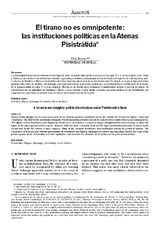Mostrar el registro sencillo del ítem
A tyrant is not almighty: political institutions under Peisistratid Athens
| dc.contributor.author | Iriarte, Unai | |
| dc.date.accessioned | 2021-09-24T09:40:57Z | |
| dc.date.available | 2021-09-24T09:40:57Z | |
| dc.date.issued | 2021 | |
| dc.identifier.issn | 1575-2100 | |
| dc.identifier.issn | 2386-4494 | |
| dc.identifier.uri | http://hdl.handle.net/10396/21609 | |
| dc.description.abstract | Modern historiography has focused its research on the Athenian political institutions of the 6th century BC on two key figures: Solon and Cleisthenes. The study of the institutions during the Peisistratid period, often because of the lack of sources on the subject, has been neglected. The Athens of both Peisistratus and Hippias has tended to be described as a relatively simple, straightforward administration, in which the figure of the tyrant operated over all areas. However, with this work, I intend to show that the legal and institutional reality of Athens in the second half of the 6th century is more complex. Many of the Solonian institutions were maintained during the period of tyranny. The coexistence of these policies with the governments of Peisistratus and Hippias sometimes facilitated, and sometimes limited, the scope of the political power of the Peisistratids and their capabilities, and therefore the influence of the tyrants on the polis administration. | es_ES |
| dc.description.abstract | La historiografía moderna ha centrado su investigación sobre las instituciones políticas atenienses del siglo VI a. C. en dos figuras clave: Solón y Clístenes. El estudio de las instituciones durante el período pisistrátida, a menudo por la falta de fuentes al respecto, ha sido dejado de lado. La Atenas de Pisístrato e Hipias se ha tendido a describir como una administración relativamente sencilla, simple, en la que la figura del tirano operaba sobre todos los ámbitos. Sin embargo, con el presente trabajo se pretende mostrar que la realidad jurídica e institucional de la Atenas de la segunda mitad del siglo VI es más compleja. Muchas de las instituciones solonianas se mantuvieron durante el período de tiranía. Su coexistencia con los gobiernos de Pisístrato e Hipias, a veces facilitó, y otras limitó, el alcance del poder político de los Pisistrátidas, sus competencias y, por tanto, la influencia de los tiranos en la administración de la polis. | es_ES |
| dc.format.mimetype | application/pdf | es_ES |
| dc.language.iso | eng | es_ES |
| dc.publisher | Asociación de Estudios de Ciencias Sociales y Humanidades | es_ES |
| dc.rights | https://creativecommons.org/licenses/by-nc-nd/4.0/ | es_ES |
| dc.source | Ámbitos 45, 11-22 (2021) | es_ES |
| dc.subject | Peisistratus | es_ES |
| dc.subject | Hippias | es_ES |
| dc.subject | Areopagus | es_ES |
| dc.subject | Archonship | es_ES |
| dc.subject | Local Justices | es_ES |
| dc.subject | Pisístrato | es_ES |
| dc.subject | Hipias | es_ES |
| dc.subject | Areópago | es_ES |
| dc.subject | Arcontado | es_ES |
| dc.subject | Jueces de demo | es_ES |
| dc.title | A tyrant is not almighty: political institutions under Peisistratid Athens | es_ES |
| dc.title.alternative | El tirano no es omnipotente: las instituciones políticas en la Atenas Pisistrátida | es_ES |
| dc.type | info:eu-repo/semantics/article | es_ES |
| dc.rights.accessRights | info:eu-repo/semantics/openAccess | es_ES |

